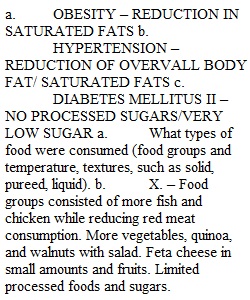


Q PBHL 2240 - Therapeutic Nutrition Fall 2022 Project 2 – Empathy – Experiencing Modified Diets DUE December 9, 2022 From Page 264 of 7th / page 266 of 8th edition of the Grodner textbook. An effective way for nursing students to learn about medical nutrition is to research modified dietary pattern guidelines and resources for specific disorders and conditions and then experience these diets personally. Following a modified diet even for 1 day provides students empathy with patients who need to change their regular eating habits and adhere to special dietary intakes. This dietary experience also supplies nursing students with strategies to reinforce teaching by dietitians. Choose one diet and follow it for at least 24 hours and even better for 2-3 days. Examples of diets High fiber and adequate liquid (eg. diverticulosis) Gluten free diet (eg. celiac disease) Low cholesterol and saturated fat diet for coronary heart disease Dietary approaches to stop hypertension (DASH) Carbohydrate restricted diet (diabetes) Use 45 % calories from carbohydrates 20 % from protein and the remainder from good fats to total 100 % FODMAP diet (IBS, GI issues) Mediterranean Diet These are the only diets to use. Questions 1. List three health problems that may make this modification necessary or desirable - - this is an important question- please make sure to at the very least list the disease condition for which the diet is used as medical nutrition therapy. 2. What general guidelines were followed? a. What types of food were consumed (food groups and temperature, textures, such as solid, pureed, liquid). b. What amounts of food were consumed? Number of calories or specific measurements c. What foods/beverages were avoided or restricted? List specific foods/beverages d. Rationale 3. What resources besides the textbook were used to learn about the diet? Were any Internet sites especially useful? 4. What was your experience? a. How did you feel physically or emotionally when following the diet? b. What did you learn by paying attention to food labels? c. What surprised you the most about this diet? d. What foods were challenging to include or eliminate? e. What were other personal barriers that made following this diet difficult? 5. Are there special dietary products that may help people with this diet? a. Are special products needed? Why b. Which of these products (helpful or not) are available? c. Which products would you buy if you were on this diet for a month? 6. What are the pros and cons of the diet? a. Benefits b. Disadvantages and/or risks 7. What aspect of this experience gave you empathy for a patient who is following this diet? a. What dietary guidelines would be especially difficult if you followed this diet for a month? Why? (e.g. cost, not wanting to be different from peers)? b. Was it necessary to learn a lot about this new information? Explain the steps taken to gain this information. c. Would it be difficult to follow this diet indefinitely? Discuss 8. How would you teach a pt. about this diet? a. What would you do to promote understanding of this diet (which foods and why?) b. What pt. education materials would assist a pt. to make wise food choices? c. What would be a reasonable goal that a pt. could achieve by the end of the first week? d. What would you recommend as the first step a pt. should take when beginning this dietary pattern?
View Related Questions